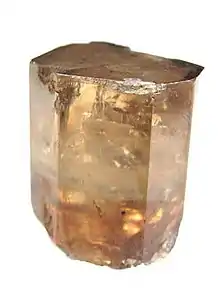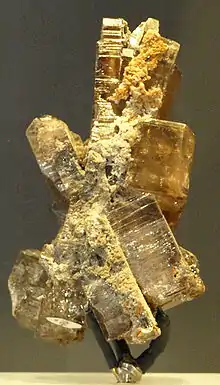| Phosgenite | |
|---|---|
 Crystal of phosgenite from the Monteponi Mine, Iglesias, Sardinia, Italy (size: 3.0 x 3.0 x 2.5 cm) | |
| General | |
| Category | Carbonate minerals |
| Formula (repeating unit) | (PbCl)2CO3 |
| IMA symbol | Pho[1] |
| Strunz classification | 5.BE.20 |
| Crystal system | Tetragonal |
| Crystal class | Ditetragonal dipyramidal (4/mmm) H-M symbol: (4/m 2/m 2/m) |
| Space group | P4/mbm |
| Unit cell | a = 8.16 Å, c = 8.883(6) Å; Z = 4 |
| Identification | |
| Color | Pale yellow to yellowish brown, pale brown, smoky brown, smoky violet, colorless, pale rose, gray, yellowish gray, pale green |
| Crystal habit | Short prismatic crystals, granular, massive |
| Cleavage | Distinct on {001} and {110}, indistinct on {100} |
| Fracture | Conchoidal |
| Tenacity | Sectile, flexible perpendicular to {001} |
| Mohs scale hardness | 2 – 3 |
| Luster | Adamantine |
| Streak | White |
| Diaphaneity | Transparent to translucent |
| Specific gravity | 6.12 – 6.15 |
| Optical properties | Uniaxial (+); anomalously biaxial if strained |
| Refractive index | nω = 2.118 nε = 2.145 |
| Birefringence | δ = 0.027 |
| Pleochroism | Weakly pleochroic with O - reddish and E - greenish in thick sections. |
| Ultraviolet fluorescence | Fluoresces yellow under LW and SW UV |
| Solubility | Soluble in dilute nitric acid with effervescence, decomposes slowly in cold water |
| References | [2][3][4][5] |
Phosgenite is a rare mineral consisting of lead carbonate chloride, (PbCl)2CO3. The tetragonal crystals are prismatic or tabular in habit: they are usually colorless and transparent, and have a brilliant adamantine lustre. Sometimes the crystals have a curious helical twist about the tetrad or principal axis. The hardness is 3 and the specific gravity 6.3. The mineral is rather sectile, and consequently was earlier known as corneous lead, (German Hornblei).[6]
Name and occurrence

The name phosgenite was given by August Breithaupt in 1820, after phosgene, carbon oxychloride, because the mineral contains the elements carbon, oxygen, and chlorine.[6]
It was found associated with anglesite and matlockite in cavities within altered galena in a lead mine at Cromford, near Matlock: hence its common name cromfordite.[7] Crystals are also found in galena at Monteponi near Iglesias in Sardinia, and near Dundas in Tasmania.[6] It has also been reported from Laurium, Greece; Tarnowitz, Poland; the Altai district, Siberia; the Touissit mine, near Oujda, Morocco; Sidi Amor ben Salem, Tunisia; Tsumeb, Namibia; Broken Hill, New South Wales; and Boleo, near Santa Rosalía, Baja California Sur. In the US it has been reported from the Terrible mine, Custer County, Colorado; the Stevenson-Bennett mine, Organ Mountains, Doña Ana County, New Mexico; and the Mammoth mine, Tiger, Pinal County, Arizona.[3]
Crystals of phosgenite, and also of the corresponding bromine compound PbBr2CO3, have been prepared artificially.[6]
See also
- Barstowite, another lead chloride carbonate
References
- ↑ Warr, L.N. (2021). "IMA–CNMNC approved mineral symbols". Mineralogical Magazine. 85 (3): 291–320. Bibcode:2021MinM...85..291W. doi:10.1180/mgm.2021.43. S2CID 235729616.
- ↑ Mineralienatlas
- 1 2 Handbook of Mineralogy
- ↑ Mindat.org
- ↑ Webmineral data
- 1 2 3 4 One or more of the preceding sentences incorporates text from a publication now in the public domain: Spencer, Leonard James (1911). "Phosgenite". In Chisholm, Hugh (ed.). Encyclopædia Britannica. Vol. 21 (11th ed.). Cambridge University Press. p. 474.
- ↑ "Phosgenite and Matlockite in Derbyshire (Part 1). T. Bridges, M. E. Smith. Journal of the Russell Society Volume 1, No. 2, p.7–14, 1983 Retrieved on 2011-01-11